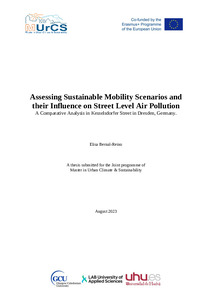Assessing sustainable mobility scenarios and their influence on street level air pollution : a comparative analysis in Kesselsdorfer Street in Dresden, Germany
Bernal Reino, Maria Elisa (2023)
Bernal Reino, Maria Elisa
2023
All rights reserved. This publication is copyrighted. You may download, display and print it for Your own personal use. Commercial use is prohibited.
Julkaisun pysyvä osoite on
https://urn.fi/URN:NBN:fi:amk-2023102327842
https://urn.fi/URN:NBN:fi:amk-2023102327842
Tiivistelmä
Air pollution is a major threat to human health and the environment. For this reason, cities must control and assure better air quality for their citizens, by enhancing a more environmentally sound urban planning and regulations towards the air pollution sources. In light of this, and considering that transportation highly contributes to air pollution, sustainable mobility strategies are presented as a solution not only for reducing air pollution, but also for promoting a better quality of life. Nonetheless, different operational limitations to conduct air pollution assessments from the municipalities, and the lack of a citizen's perspective within the pollution analysis, have limited the understanding of the real benefits/impacts of street-level mobility projects. Through the use ADMS-Roads dispersion model and surveys on people’s experiences as a dual approach, this study has provided a detailed assessment for mobility scenarios that aim to reduce air pollution in Kesselsdorfer street in Dresden. Particularly, showing that shifting from cars towards more sustainable transportation methods contribute to further reduction of emissions. Moreover, dispersion models and people’s perceptions go hand in hand, so if the amount of pollution increases in the simulations, so does the citizen’s perception of high levels of pollution. This study considered different exploratory scenarios for Kesselsdorfer street, where a radical scenario that reduces the number of private cars by 11.8% and increases the amount of public transport by 3.5%, has the potential to cut NO2, PM10, and PM2.5 emissions by 91.6%, 66.26%, and 67.61% respectively, compared to the current situation. On the other hand, a dystopian scenario was also created where the number of vehicles increased three times, resulting in higher emissions (35.16% for NO2, 35.37% for PM10, and 38.03% for PM2.5) and in the rejection by the respondents; implying that a car-centred vision should not be considered again. All the assessed scenarios presented two constant hotspots that coincide with the areas of high commercial activity, this shed a light to develop more actions or interventions to ensure people’s air quality. The results from combining a quantitative and qualitative resonate with current research that emphasises that day-to-day experiences of residents cannot be overlooked, as well as other elements of the streetscape like vegetation. Planners must assess air pollution by understanding its extend and complexity, including local communities’ perspectives and showing willingness to adopt and implement sustainable measures; this will allow more informed decisions and better local and beyond regulations.
